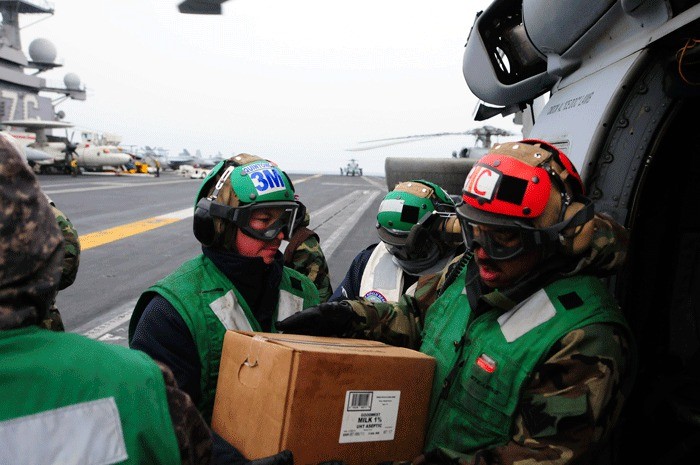Nearly 200 Whidbey Island Naval Air Station sailors are participating in relief efforts off the east coast of Japan.
Electronic Attack Squadron VAQ-139, the Cougars, deployed aboard the USS Ronald Reagan in January. The ship, which serves as the core of the Navy’s 7th Fleet carrier strike group, was in the area when a huge 9.0 earthquake, followed by a devastating tsunami, rocked eastern Japan Friday afternoon.
Speaking from the Reagan by telephone Tuesday morning, ship spokeswoman Lt. Cmdr. Kate Meadows said the strike group was now in its third day of operations, delivering items such as food, blankets and personal hygiene products to victims of the disaster.
Although flight operations have been suspended, effectively grounding Cougars pilots from their Prowler aircraft, the squadron’s support personnel have been assisting in the loading of helicopters shuttling emergency supplies to the coast.
“It’s a whole team effort aboard the ship,” Meadows said.
“When events like this happen, everyone pulls together,” she said.
As of Tuesday morning, a total of 29 sorties (helicopter missions) had delivered about 25 tons of supplies, assisting about 2,000 people. The missions have not been without risk, however. On Monday, the strike group repositioned itself after 17 Navy personnel were exposed to low levels of radiation.
The service members were aboard three helicopters that had flown through radioactive plumes from the Fukushima Dai-Ichi Nuclear Power Plant, which was damaged in the disaster, according to Lt. Anthony Falvo, a spokesman for the 7th Fleet.
The flight crews, along with the ship, underwent decontamination procedures, which are basically nothing more than scrubbing with soap and water. No one was injured as the level of contamination was equal to about 30 days’ exposure to the sun, he said.
“It’s not cause for alarm but something we have to watch very carefully,” Falvo said.
Meadows confirmed that no one aboard the Reagan was ever ill or has since shown signs of illness due to the exposure. It was only through the ship’s sophisticated onboard detection equipment that personnel were alerted to the presence of the radioactive particles.
The strike group, which was about 100 miles northeast of the power plant at the time, has since repositioned itself to avoid any further exposure. It’s simply a matter of monitoring the weather and watching for wind shifts, Meadows said.
There are currently nine ships in the strike group but another four are en route to the area. While the Reagon serves as the central hub of the Navy’s support wheel, the other ships — including cruisers, destroyers, and amphibious landing-craft — are all playing their own roles.
Some are searching the seas for survivors while others are transporting Japanese Defense Force personnel and support craft to critical areas. As the 7th Fleet is based in U.S. Fleet Activities Yokosuka, this mission has special significance for many sailors.
“Japan is home,” Falvo said. “This is where we’re stationed. Our own families are here.”
As for those on the Nimitz-class, nuclear-powered supercarrier, which calls San Diego home, Meadows said there is a very positive attitude among the ships complement of about 4,500. The crew knows the work they are doing is vital to the relief effort and that they are assisting thousands of people recover from one of Japan’s worst natural disasters.
“It makes us feel good we’re out here doing a good job,” Meadows said.



